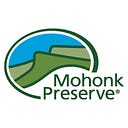Research Report #18 — Sublimation from Mohonk Lake Ice
For many years scientists and naturalists have been studying and observing the flora and fauna of the Shawangunk Ridge. Foremost among them was Daniel Smiley, for whom Mohonk Preserve’s Daniel Smiley Research Center is named. Dan wrote numerous reports summarizing his observations on various topics. This regularly occurring series will feature some of these reports; some hold tremendous scientific value today and just await an interested researcher to follow up, others showcase a quirky sense of humor or highlight an oddity of nature.
Read the report: Sublimation from Mohonk Lake Ice. 16 March 1980. Daniel Smiley.
A note from Paul C. Huth, Director of Research Emeritus: I clearly remember assisting Mohonk Trust Director of Research Daniel Smiley with this winter experiment, investigating the loss of the thickness of ice from its surface through a process called sublimation. Dan was always interested in warm season evaporation from Mohonk Lake since he was appointed as Weather Observer of the Mohonk Lake Cooperative Weather Station of the U.S. Weather Bureau in December, 1937. In addition to daily weather readings at Mohonk, lake height measurements were also recorded. These measurements were made on an iron Lake Height Measuring Rod that had been established by the Smiley Family, owners of the Mohonk Mountain House, in 1899, at the location of the historic outlet. Daily readings started on December 16, 1899. These measurements, as Dan noted, “revealed a drop in (lake) level from one day to another even under conditions of no precipitation, no run off,….or direct domestic use.”
In preparing an annual water budget for Mohonk using long term lake height measurements, it was clear that some value for winter ice sublimation was lacking and would be helpful. Sublimation is a process where ice looses volume by changing directly to vapor without first melting. Dan consulted with friend and Mohonk Trust Research Associate Dr. Stephen Egemeier, Professor of Geology at SUNY New Paltz, who suggested an experimental design. On over a foot of lake ice, Dan picked a spot on the surface some 65 feet from the northeast shore of Mohonk Lake and we drilled holes and froze in two oak stakes a foot apart. They were sawed off level at some 8” above the ice. From a straight edge laid across the tops, measurements were made down to the ice surface.
Over a two week period as much as 1/16th of a inch of ice loss was measured on six days. On two days when the temperature was warmer with low humidity, as much as 1/8 inch of ice was lost. Overall, 9/16th of an inch of ice was lost during the duration of the experiment. Of particular interest to Dan was the amount of potential water lost as a result of the ice surface sublimation. For the 17 surface acre lake and the 9/16th of an inch loss of ice over the two week period, Dan calculated nearly 260,000 gallons had evaporated! Of course, Dan noted that ice surface sublimation was related to “variables (like) temperature, relative humidity, and wind-as open water, but is also influenced by whether the ice is snow covered and whether, under no snow conditions, it is snow ice or clearwater ice.”
Recently, on the topic of sublimation, Bob Berman, noted scientist and astronomer, wrote a short article entitled “Disappearing crystals…and a devine February verb,” which appeared in Almanac Weekly, February 8, 2018.
Read the report: Sublimation from Mohonk Lake Ice. 16 March 1980. Daniel Smiley.
